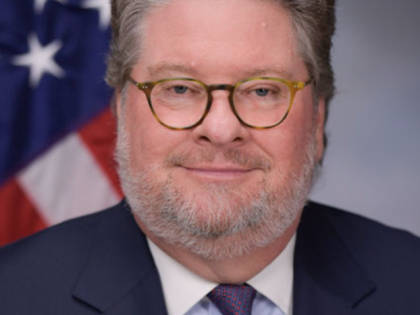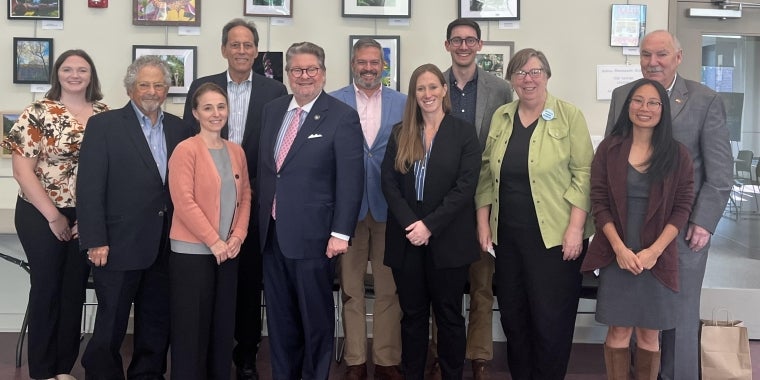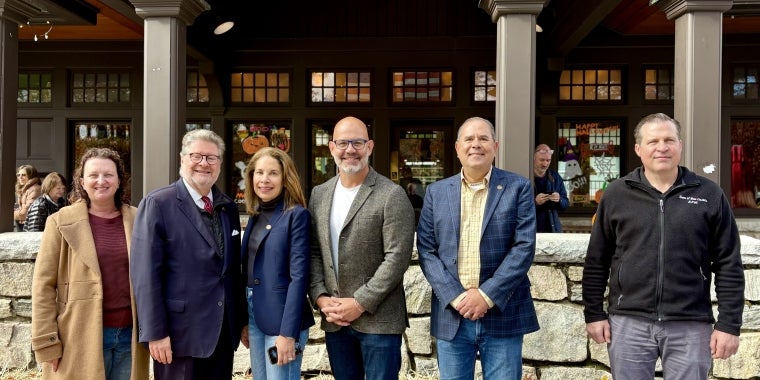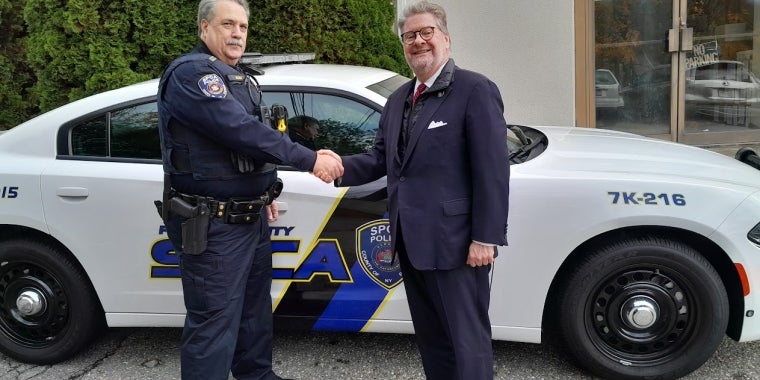
Harckham Hosts Environmental Protection Roundtable in Mount Kisco
October 16, 2024
-
ISSUE:
- Senator Harckham. SD40
- Clean Water; Environmental Protection
- Enviromental Conservation
- Clean Air
- CLCPA

Sen. Harckham with Environmental Protection Roundtable participants
Mount Kisco, NY – New York State Senator Pete Harckham hosted an Environmental Protection Roundtable last week at the Mount Kisco Public Library, where a blue-ribbon group of advocates and attorneys had an opportunity to share their concerns about safeguarding our natural resources while outlining their priorities for the coming legislative season. Harckham, as chair of the Senate Environmental Conservation Committee, held the roundtable to help inform his work in the upcoming Senate session.
In the wake of the June 2024 decision from the U.S. Supreme Court overturning the Chevron doctrine, a 40-year precedent that required courts to defer to regulatory decisions made by federal agencies, there is great concern that a number of environmental protections will now be challenged in the courts. Also, New York State and its municipalities continue to pursue the ambitious goals set forth in the landmark Climate Leadership & Community Protection Act (CLCPA), while confronting the challenge of conserving fragile drinking water sources from emerging contaminants and managing solid waste.
Joining Harckham at the Environmental Protection Roundtable were:
- Kate Donovan, Senior Attorney and Northeast Director of the Natural Resources Defense Council (NRDC);
- Matthew Salton, Federal Policy Manager for the New York League of Conservation Voters (NYLCV);
- Todd D. Ommen, Managing Attorney for the Pace Environmental Litigation Clinic and Professor at Elisabeth Haub School of Law at Pace University
- Judith Enck, Founder and President of Beyond Plastics and former U.S. Environmental Protection Agency (EPA) Regional Administrator
- Robert Hayes, Senior Director of Clean Water with Environmental Advocates NY
- Victoria Leung, Staff Attorney at Riverkeeper;
- Rand Manasse, Board Member with Federated Conservationists of Westchester County
Steve Levy, Board Chair and Co-Vice President with Federated Conservationists of Westchester County
Following welcoming remarks from Harckham and Mount Kisco Mayor J. Michael Cindrich, the roundtable participants commenced a detailed discussion of the U.S. Supreme Court’s Loper Bright Enterprises v. Raimondo decision, which significantly changed the law regarding judicial review of administrative action and rulemaking by overturning the longstanding Chevron doctrine. This decision opened the door to expanding the judiciary’s power to review and reject interpretations of statutes adopted by federal agencies.
The Chevron doctrine allowed for agency interpretations of congressional statutes. In overruling the doctrine, federal courts can now draw their own conclusions about what they feel is the correct legal interpretation of ambiguous laws—instead of deferring to the agencies that would enforce and administer those laws and regulations.
With this in mind, Ommen pointed out that courts “will look at agency analysis (of laws) but will not be deferred to it.” So, if the U.S. Environmental Agency (EPA) has its authority cut back, more responsibility to enact laws and enforce regulations would fall back on the state”—and if a Clean Air Act regulation is struck down, “you could adopt a state standard to backstop it.” In other words, Ommen said, “You could enact a comprehensive statute that states that if a federal standard is invalidated by the (Supreme) Court, it will remain in effect in New York State.”
Ommen noted that the highly detailed regulations that the EPA promulgated under the Clean Water Act are not mirrored at the state level—a potential problem if the high court overturns them.
In response, Donovan thought the ramifications of the Loper Bright Enterprises v. Raimondo decision were being both “overstated and understated.” Other states had already enacted laws that mirror the deference doctrine, she said, but New York was not one of them. Because the decision will impact federal regulations that have a local impact, New York should be ready. Enck was less sanguine about the decision, calling it “very bad,” especially if it ends up changing clean air and water regulations, as well as Superfund site reauthorizations.
Summarizing the discussion of consequences from the Loper decision, Hayes stated that it is the generalities in federal law that creates these issues, which is why “statutory clarity is an important preventative.” More clarity and more details in the state’s original legislation, he added, would make it less likely for a court to invalidate a regulation. Enck saw this proactive legislating as “an opportunity to prevent pollution, rather than regulate.” Other roundtable participants envisioned well-conceived state regulations that would protect the environment from a whole range of pollutants and toxins in what are now unregulated areas.
In a post-Loper nation, Manasse said that informing residents of the risks of underregulation was necessary, as was fully explaining what is entailed by maintaining clean water and air. The protection of fragile drinking water supplies, replacing lead pipes in municipalities statewide, eliminating synthetic chemicals like PFOS and PFAS—all drew pointed discussion in terms of what other environmental issues remain troublesome.
Finishing with some legislative ideas for the upcoming new year, the roundtable participants returned to protecting federal statutes, if overturned by the courts, with stringent state regulations. The idea of New York’s Environmental Rights amendment to its state constitution, enshrined by popular vote in 2021, was discussed, along with a waste management bill.
“This gathering was certainly a productive one, as everyone at the roundtable was able to share important information from their perspectives and enlarge their understanding of how we can move forward in protecting New York’s environment,” said Harckham, chair of the Senate Environmental Conservation Committee. “I am pleased that participants were willing to contribute their time and expertise at this event, and look forward to utilizing the information in the upcoming legislative session.”
Robert Hayes, Senior Director of Clean Water with Environmental Advocates NY said, “The US EPA has finalized landmark regulations on drinking water quality, which will protect the public’s health. Local water utilities will need resources to comply with new requirements to remove toxic PFAS chemicals from drinking water and replace dangerous lead pipes. 300 utilities are expected to exceed EPA’s new PFAS standards, and 500,000 lead pipes need to be dug out of the ground. That’s why investing in New York’s Clean Water Infrastructure Act is a major priority. CWIA has been essential to helping communities meet requirements and afford necessary infrastructure upgrades. Building the capacity of local governments to achieve new public health protections is essential.”
Judith Enck, the former EPA Regional Administrator, said, “The Supreme Court's decisions boxing in our environmental agencies are bad news for those that breathe air and drink water. We need bold state level action. We need to be getting rid of toxic chemicals at their source, rather than attempting to regulate them after they’ve entered the stream of commerce. Similarly, we need to cut our municipal solid waste generation. These are areas where the state can take the lead to protecting the public. We must seize the initiative to not only regulate pollutants but prevent pollution.”
Todd D. Ommen, Managing Attorney for the Pace Environmental Litigation Clinic and Professor at Elisabeth Haub School of Law at Pace University, said, “Earlier this year, the Supreme Court struck down the respect courts have been providing to agencies for 40 years. The overturning of the Chevron doctrine has created uncertainty in the world of environmental protection. Without deference to agency interpretation, the highly detailed regulations that the EPA has promulgated under federal statutes like the Clean Water Act could be challenged anew. Many of these regulations are not mirrored at the state level—states expressly rely on the federal standards. Historically this has not been an issue, but if we lose the federal ‘floor’ of protection, our environmental protections are at risk.”



